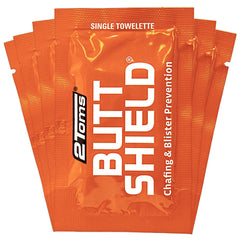FREE SHIPPING ON ORDERS OVER $25*
FREE SHIPPING ON ORDERS OVER $25*

Spend any time with cyclists and you are bound at some point to hear them lamenting about saddle sores. It’s not a pretty subject, but cycling saddle sores are a common affliction for cyclists. Even the smallest of cycling saddle sores can be extremely painful and ruin a bike ride. Most medical experts say that saddle sores are actually boils caused by skin bacteria that invade surface abrasions. Cycling saddle sores typically have three stages: mild skin abrasion and chafing, red acne lumps (folliculitis), and abscess. The 3rd stage, abscess, usually requires seeking medical treatment.
To some extent, saddle sores are inevitable and cannot be completely avoided, but here are some ways to help prevent cycling saddle sores as much as possible:
Beginner cyclists, or cyclists returning from a break, need to make sure they leave time for getting used to being in the saddle. When cyclists start off with very long rides and they are unaccustomed to the saddle, a cycling saddle sore is much more likely. Also, as a rider’s legs get stronger, they are able to take a bit more weight off the posterior which can help protect sensitive areas.
If the seat is too high, a rider’s hips rock on each pedal stroke and increase friction across the nose of the saddle. The result is irritated skin and a greater chance of saddle sores. It is a good idea for cyclists to have their position checked by a coach or knowledgeable bike shop person.
Saddle choice is very important. Wide saddles can chafe inner thighs while narrow saddles might not provide enough support for cyclist’s sit bones. Thickly padded saddles can press upward between your sit bones, causing uncomfortable numbing pressure. The best seat choice for any rider is usually found through trial and error.

2Toms ButtShield
Chafing and Blister Prevention
★★★★★
2Toms ButtShield has an easy roll-on applicator and will last all day. Applying ButtShield to the groin area, thighs, buttocks, and surrounding areas, will reduce friction and protect skin from rashes and cycling saddle sores. It is waterproof, non-greasy, and non-toxic.
A saddle sore is more likely if you are rocking around the saddle. Cyclists who have stronger core muscles can keep a strong position on the bike which will help reduce the irritation that can lead to cycling saddle sores.
Standing helps take off the saddle and restores circulation. Get in the habit of standing for 15-20 seconds every few minutes. Take advantage of opportunities such as short hills, rough pavement, or accelerating from stop signs.
Sit mostly toward the rear where your sit bones get maximum support and take pressure off your groin area. Try moving farther back on seated climbs and more to the middle when bending low. Each position shift relieves pressure points and can help reduce the chance of developing cycling saddle sores.
To reduce the possibility of saddle sores, it is important to use a good cycling short. Look for shorts with a one-piece liner or one that is sewn with flat seams. It may take experimenting with shorts brands to find the model that works best. Women often do better with shorts designed specifically for their anatomy and that have a liner with no center seam.
Always wear clean shorts for each ride and remove sweaty shorts as soon as possible after a ride. Since cycling saddle sores can develop when bacteria is present on chafed areas, it is important to shower and put on loose-fitting clothes that will allow skin to breathe right after a bike ride.

2Toms ButtShield
1.50oz Roll-On
★★★★★

2Toms ButtShield
6-Pack Towelettes
SPORTSHIELD: THE MUST HAVE CHAFING AND RUBBING PROTECTION FOR JUST ABOUT ANY ACTIVITY
3 COMMON TYPES OF BLISTERS AND PREVENTION
PREVENT SKIN IRRITATION FROM MEDICAL MASKS
5 REASONS WHY YOU SHOULD STRETCH IN THE MORNING
PLEASE NOTE: The information on this website and article is for information only and should not be used as a substitute for consulting your doctor. Consult your doctor for proper diagnosis and rehabilitation.


